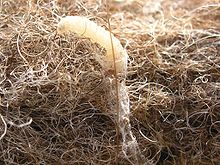

The caterpillars of the Common Clothes Moth, or Webbing Clothes Moth are considered a serious pest in many homes

homes across the world, as they can derive nourishment from clothing – in particular wool, but many other natural fibers – and also, like most related species, from stored produce.
Free Estimate
Range and ecology
Its natural range is western Eurasia, but has been transported by human travelers to other localities.
This moth prefers moist conditions, although low humidity will merely slow development. Webbing Clothes Moths are small moths whose adults grow to between 1 and 2 cm in length. Their eggs are tiny, most being under 1 mm long and barely visible. A female will lay several hundred during her lifetime; egg placement is carefully chosen in locations where they will have the best chance for survival.
The eggs are attached with a glue-like substance and can be quite difficult to remove. After the egg hatches, the larva will immediately look for food. Larvae can obtain their required food in less than two months, but if conditions are not favorable they will feed on and off for a long time. Whether it takes two months or two years, each larva will eventually spin a cocoon in which it will pupate and change into an adult. Larvae stay in these cocoons for between one and two months and then emerge as adults ready to mate and to lay eggs.
Damage caused by Clothes Moths
This species is notorious for feeding on clothing and natural fibers; they have the ability to turn keratin (a protein of which hair and wool mainly consist) into food. The moths prefer dirty fabric and are particularly attracted to carpeting and clothing that contains human sweat or other liquids which have been spilled onto them.

They are attracted to these areas not for the food but for the moisture: the caterpillars do not drink water; consequently their food must contain moisture.
Both adults and larvae prefer low light conditions. Common Clothes Moths seem to prefer dim or dark areas. If larvae find themselves in a well-lit room, they will try to relocate under furniture or carpet edges. Handmade rugs are a favorite, because it is easy for the larvae to crawl underneath and do their damage from below. They will also crawl under moldings at the edges of rooms in search of darkened areas where debris has gathered and which consequently hold good food.
The eggs hatch into larvae, which then begin to feed. Once they have finished larval development, they pupate and undergo metamorphosis to emerge as adult moths. Adults do not eat; rather, males look for females with whom to mate, and females look for places to lay their eggs. Once reproduction is done, they die. Contrary to what most people believe, adult clothes moths do not eat or cause any damage to clothing or fabric. It is the larvae which are solely responsible for this, and which spend their entire time eating and foraging for food.
Pest control
Control measures for Clothing Moths include the following:
- Physical measures
- Clothing moth traps – this step can help monitor the current infestation and prevent males from mating with females
- Cryofumigation – Fumigating an object with dry ice, that is enclosing it in a plastic bag for 3–5 days with dry ice so it is effectively bathed in a high concentration of carbon dioxide, denied oxygen, and thus it will kill all stages of clothing moths. For details, see Clothes Moths Management Guidelines, under "Household Furnishings".
- Dry cleaning – This step kills moths on existing clothing and helps remove moisture from clothes
- Freezing – Freezing the object for several days at temperatures below 32 °F (0 °C)
- Heat (120 °F or 49 °C for 30 minutes or more) – these conditions may possibly be achieved by placing infested materials in an attic in warm weather, or by washing clothes at or above this temperature. Specialist pest controllers can also provide various methods of heat treatment for this very purpose.
- Sunlight – has a limited effect
- Vacuuming – Since the moths like to hide in carpeting and baseboards, this is an important step towards full eradication
- Mothballs – are used primarily as a preservative but also will kill existing larvae if the concentration is high enough. There are two types of mothball: early 20th century ones were based on naphthalene, while mid 20th century ones used paradichlorobenzene. Both evaporate into a gas, which is heavier than air and needs to reach a high concentration at the protected material to be effective. Disadvantages: somewhat toxic and carcinogenic, mothballs should not be put where they can be eaten by children or pets. Naphthalene mothballs are also highly flammable.
- Biological measures
- Camphor (Cinnamomum camphora) – a safer and more natural alternative to mothballs but may require high vapour concentrations
- Eastern Red Cedar (Juniperus virginiana) – questionable value as long-term deterrent. While the volatile oil is able to kill small larvae, it is difficult to maintain sufficient concentrations of it around stored articles to be effective; cedar wood loses all moth-suppressant capabilities after a few years. Other cedar species may have better or worse effects.
- Common Lavender (Lavandula angustifolia) – either bags with dried lavender flowers are put into the wardrobe (they can be refreshed by putting a few drops of lavender oil on them), or a few drops of lavender oil are put on a piece of fabric which is then deposited in the wardrobe and periodically refreshed. Disadvantage: strong "perfumed" smell
- Ichneumon wasps (e.g. Trichogramma evanescens) – tiny parasitoid wasps which place their own eggs beside those of the moths; when hatching their larvae eat the moth eggs. Ichneumon wasps are harmless to humans, measuring only about 2 mm. Once all moth eggs are eaten, the wasps vanish within 2–4 weeks.
